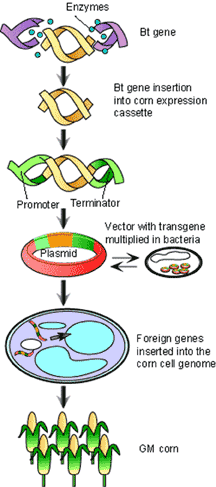Genetically Modified Crops are a type of GMO (Genetically Modified Organism.) They go under a process of genetic engineering in which the crops are modified in laboratories to have to have specific traits such as resistance to herbicides and pests. To understand the process of genetic engineering, one must understand the importance of the DNA.
 | What is DNA? Deoxyribonucleic acid, or DNA for short, is the storage for the hereditary information in almost all organisms. Most every single cell contains DNA in its nucleus, though some strands of DNA may be found in the mitochondria. DNA is made up of links of nucleotides, which contain the genetic information of different genes. The process of genetic engineering is based on the genetic information of many different species of organisms. 1 |
3. This new plasmid now contains an extra gene that can be cloned or duplicated in large amounts when placed back into the bacteria. The molecule can also be inserted in another host cell and replicated with the host's DNA as it goes through cell division. These divisions create numerous cells that are clones of the identical cell. This means it has a copy of the donor DNA molecule.
4. This creates a permanent change in the DNA and the genetic make up of the host organism. 2
This is the most familiar method of Genetic Engineering and known specifically as the Plasmid Method. The other three methods are the Vector, Biolistic, and Electroporation Methods.
What are Cisgenes and Transgenesis?
Cisgenes and transgenes are two different types of genetic engineering. Below are both types along with the definition of each taken from Embo Reports. 3
 | "Cisgenesis is the genetic modification of a recipient plant with a natural gene from a crossable—sexually compatible—plant. Such a gene includes its introns and is flanked by its native promoter and terminator in the normalsense orientation.Cisgenic plants can harbour one or more cisgenes, but they do not contain any transgenes. " |
 | "Transgenesis is the genetic modification of a recipient plant with one or more genes from any non-plant organism, or from a donor plant that is sexually incompatible with the recipient plant. This includes gene sequences of any origin in the anti-sense orientation, any artificial combination of a coding sequence and a regulatory sequence, such as a promoter from another gene, or a synthetic gene." |
